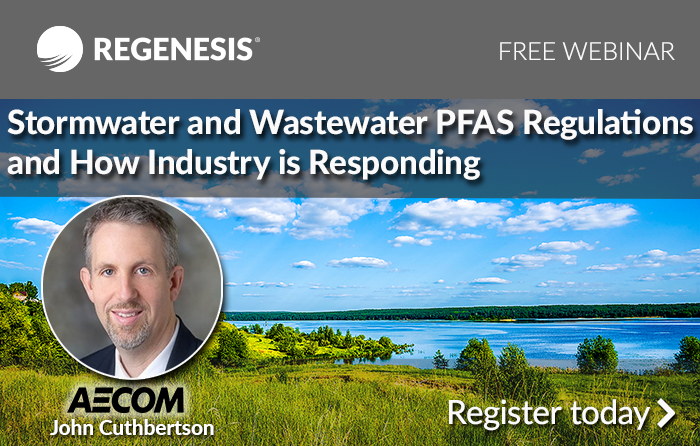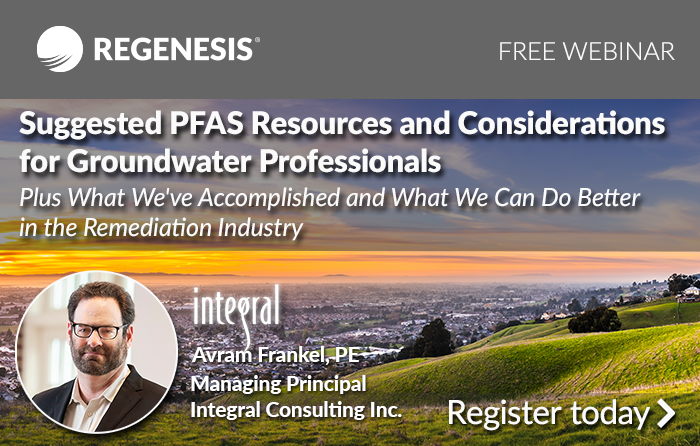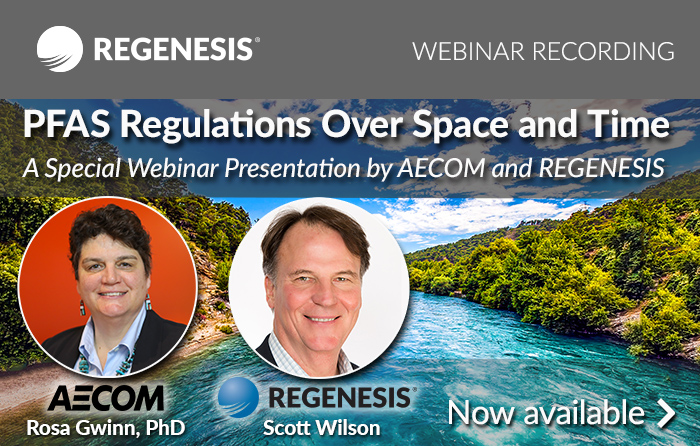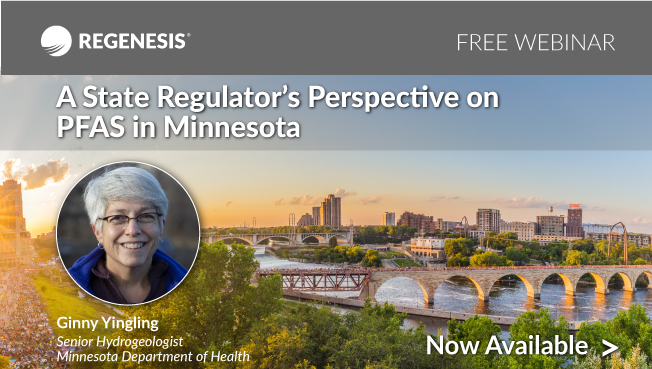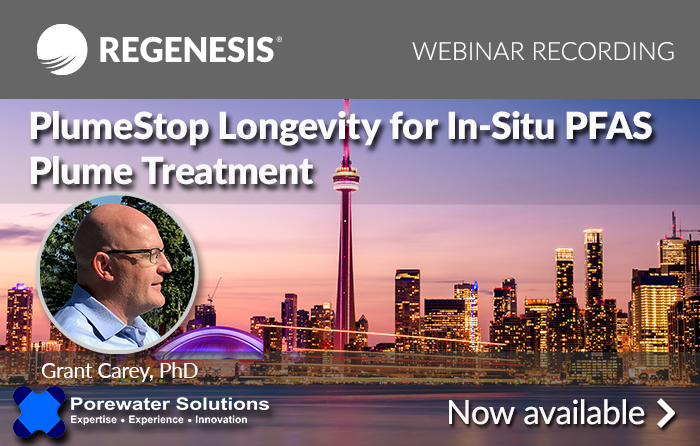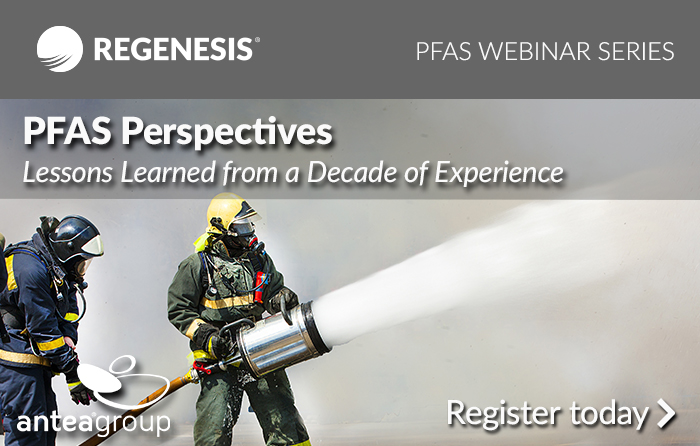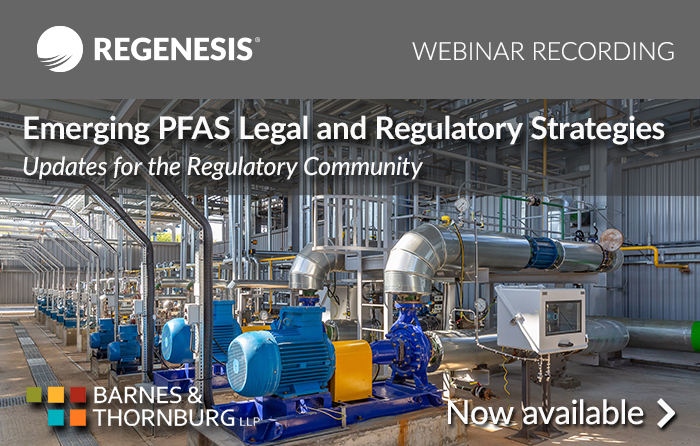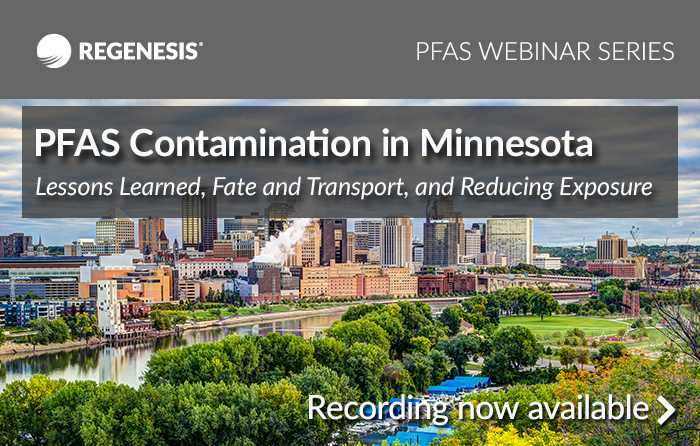Identifying PFAS as a CERCLA Hazardous Substance: Are You Ready for This?
In this webinar we were pleased to have a special presentation from Ned Witte, Attorney at Godfrey & Kahn, S.C. Ned’s presentation discussed collateral consequences of identifying PFAS as a CERCLA hazardous substance.
This free webinar will discuss the following collateral consequences of identifying PFAS as a CERCLA hazardous substance:
- U.S.EPA CERCLA administrative order and cost recovery authority
- Private party cost recovery and contribution actions
- Impacts on CERCLA five-year reviews and closed sites
- CERCLA defenses and exemptions, including the innocent landowner defense and bona fide prospective purchaser eligibility
- Interface with state PFAS regulations
- Applicable or Relevant and Appropriate Requirements (ARARs)
- Environmental due diligence and the evolution of the ASTM standard to address PFAS and emerging contaminants
- Impacts on transactions and Brownfields
On July 13, 2021, the United States House of Representatives approved the PFAS Action Act, which currently sits before the United States Senate for further action and possible approval. If enacted, the PFAS Action Act would require the United States Environmental Protection Agency to designate two PFAS, known as PFOA and PFOS, as Comprehensive Environmental Response Compensation and Liability Act “hazardous substances” within one year and to make a similar determination on other PFAS substances within five years. Some observers believe that if Congress doesn’t pass PFAS legislation, U.S.EPA may act on its own. Such a CERCLA hazardous substance identification sounds intuitively appropriate, but what are the practical effects? Join Ned Witte, an experienced PFAS lawyer and lecturer, as he discusses collateral consequences of identifying PFAS as a CERCLA hazardous substance.
View webinar recording
Stormwater and Wastewater PFAS Regulations and How Industry is Responding
In this webinar we were pleased to have as a special guest speaker John Cuthbertson, Associate Vice President and North America Industrial PFAS Lead at AECOM. Mr. Cuthbertson’s presentation looked at stormwater and wastewater PFAS regulations and how industry is responding. He was joined by Scott Wilson, President & CEO at REGENESIS, who shared the latest developments about colloidal activated carbon’s use in the remediation industry as a low-cost method of eliminating PFAS risk.
Highlights of this webinar:
- Several states have taken different and unique approaches to regulate and identify PFAS sources to stormwater and wastewater
- Facilities are being required to address PFAS discharges in stormwater and wastewater rapidly
- Several case studies will provide insight for how facilities are responding to these regulatory drivers
- An update on the use of PlumeStop to eliminate risk on PFAS sites globally
Sign up today
Suggested PFAS Resources and Considerations for Groundwater Professionals – Plus What We’ve Accomplished and What We Can Do Better in the Remediation Industry
In this webinar we were pleased to have a special presentation by Avram Frankel, P.E., Managing Principal at Integral Consulting Inc.. His presentation discussed PFAS resources and considerations for groundwater professionals, plus what we’ve accomplished and what we can do better in the remediation industry. He was joined by Ryan Moore, PFAS Program Manager at REGENESIS, who discussed in situ treatment of PFAS using colloidal activated carbon to eliminate PFAS risk at a low cost.
Highlights of this webinar:
- The evolution of remediation hydraulics, direct push technologies, next generation in situ reagents, and integrated site remediation and drinking water treatment strategies.
- Key market forces that continue to shape our industry such as insurance, government funding and litigation.
- What has been achieved in the remediation industry, what could be done better, and how we will meet new challenges.
- An update on the use of PlumeStop to eliminate risk on PFAS sites globally.
This webinar will expand on these topics, touch on some broader environment, social and governance topics, and highlight some important considerations in the assessment and mitigation of emerging contaminants such as per-and polyfluoroalkyl substances, a topic Mr. Frankel explored in recent article published in the journal Groundwater (https://doi.org/10.1111/gwat.13101).
Recording Now Available
PFAS Regulations Over Space and Time
In this webinar we were pleased to have as a special guest speaker Rosa Gwinn, PhD PG, Global PFAS Technical Lead at AECOM. Dr. Gwinn’s presentation looked at where PFAS regulations started and where they may be headed globally, including the United States. She was joined by Scott Wilson, President & CEO at REGENESIS, who shared the latest developments about colloidal activated carbon’s use in the remediation industry as a low-cost method of eliminating PFAS risk.
Highlights of this free webinar:
- Where PFAS regulations started and where they may be headed globally, including the United States
- A brief explanation of how public health concerns about PFAS created the pressure to drive regulatory actions that differed country-by-country and state-by-state
- How public health interest and research funding are rapidly changing the scientific understanding of the behavior, toxicity, and fate of individual PFAS in the environment
- Predicting the future of regulations based on what has happened in different jurisdictions
- An update on the use of PlumeStop to eliminate risk on PFAS sites globally
Recording now available
A State Regulator’s Perspective on PFAS in Minnesota
In this webinar we were pleased to have as a special guest speaker Ginny Yingling, Senior Hydrogeologist at Minnesota Department of Health. Her presentation shared a state regulator’s perspective on PFAS in Minnesota. She was joined by Scott Wilson, President & CEO at REGENESIS, who discussed the extent to which colloidal activated carbon has been accepted by the remediation industry as a low-cost method of eliminating PFAS risk.
Highlights of this free webinar:
- Updates on the investigation of several legacy PFAS waste disposal sites that impacted the drinking water of over 140,000 residents in 18 suburban communities east of St. Paul and contaminated the groundwater in an area of over 150 square miles
- The important role that surface water transport of PFAS has played at two sites in Minnesota
- Actions the state is taking to address the situation in the wake of the 3M settlement
- How Minnesota is looking forward to addressing PFAS statewide
View this free webinar
PlumeStop® Longevity for In-Situ PFAS Plume Treatment
In this webinar we were pleased to have as a special guest speaker Grant Carey, Ph.D., President of Porewater Solutions. His presentation discussed PlumeStop longevity for in-situ PFAS plume treatment. He was joined by Ryan Moore, PFAS Program Manager at REGENESIS, who discussed in-situ treatment of PFAS using colloidal activated carbon to eliminate PFAS risk at a low cost.
Highlights of this free webinar:
- Modeling the performance results of PFAS-impacted groundwater sites treated with colloidal activated carbon, including model runs to evaluate longevity sensitivity at AFFF sites
- How some of the design parameters may be engineered to improve longevity
- Several new research projects with the University of Waterloo, University of Toronto, and Carleton University to update the ISR-MT3DMS model functionality to improve our ability to model PlumeStop longevity for PFAS
View this free webinar
Six Pilot-Scale Studies Evaluating the In-Situ Treatment of PFAS in Groundwater
Highlights of this free webinar:
- The results from the adsorption-based permeable reactive zones (PRZ) indicated that attenuation of the PFAS was occurring.
- Colloidal activated carbon (CAC)-based PRZ showed the best performance with all the PFAS analyzed being removed to below their respective detection limits (10 ng/L).
- The powdered activated carbon (PAC)-based PRZ showed variable treatment.
- The biochar and ion exchange resins (IER) PRZs initially attenuated the PFAS but then had breakthrough of the C4 PFAS compounds prior to the 6-month post-injection sampling event, with the remainder of the PFAS compounds breaking through prior to the 9-month post injection sampling event.
In this webinar we were pleased to have as a special guest speaker Rick McGregor, President of InSitu Remediation Services Ltd. His presentation discussed six pilot-scale studies evaluating the in-situ treatment of PFAS in groundwater. PFAS are an emerging suite of compounds that have gathered wide-spread attention but have few remedial options. Research and limited field studies suggest that some reagents have promise for the removal of PFAS from groundwater. Six reagents were chosen for pilot testing including hydrogen peroxide, unactivated sodium persulfate, CAC, PAC, biochar and IER to determine if the reagents could be effective at reducing/removing the PFAS. Various PFAS were detected within the pre-treatment groundwater including PFDS, PFBA, PFPeA, PFHxA, PFHpA, PFOA, PFOS and PFNA with concentrations ranging up to 18,000 ng/L for PFPeA. Six pilot-scale permeable reactive zones (PRZs) were created in a shallow, unconfined aquifer situated in a slightly saline, sulfate-iron reducing environment. The groundwater was also impacted with gasoline-range petroleum hydrocarbons along with various additives including MTBE and TBA.
View this free webinar
PFAS Perspectives: Lessons Learned from a Decade of Experience
In this webinar we were pleased to have as a special guest speaker Jack Sheldon, Senior Remediation Specialist at Antea Group, and Caron Koll, PG, LSP, and PFAS Lead at Antea Group. Their presentation discussed lessons learned from a decade of experience working with PFAS contaminants in groundwater. Through more than a decade of developing sampling programs and interpreting PFAS analytical data, many lessons have been learned and this webinar will focus on a few of those lessons. They were joined by Kristen Thoreson PhD, VP of Research and Development at REGENESIS, who discussed eliminating risk from PFAS via low-cost, in-situ remediation with colloidal activated carbon.
Highlights of this free webinar:
- How to create a custom sampling program, demonstrated by a case study of an environmental site
- A method you can use to sort the chaos out of your data
- How to determine whether a product contains PFAS by looking at a Safety Data Sheet (SDS)
View this free webinar
Emerging PFAS Legal and Regulatory Strategies: Updates for the Regulatory Community
In this webinar we are pleased to have as a special guest speaker Charles M. Denton, Esq., partner at Barnes & Thornburg LLP and immediate past chair of the firm’s national Environmental Law Department. Charles Denton provides an overview of the emerging legal and regulatory considerations for PFAS contamination and key topics for the regulatory community, including businesses and local governments. He is joined by Chad Northington, Southeast District Technical Manager at REGENESIS, who will discuss low-cost, in situ remediation of PFAS using colloidal activated carbon.
Highlights of this free webinar:
- What are the likely sources of PFAS compounds?
- What are the PFAS exposure pathways of concern?
- How are PFAS compounds regulated, and what’s next?
View the recording of this free webinar
PFAS Contamination in Minnesota: Lessons Learned, Fate and Transport, and Reducing Exposure
In this webinar we are pleased to have a special guest presentation by Virginia (Ginny) Yingling, Senior Hydrogeologist in the Environmental Health Division of the Minnesota Department of Health. Ginny discusses PFAS contamination in Minnesota, including lessons learned from the state’s investigation of a chemical production facility, contaminant fate and transport, and reducing exposure. She is joined by Kristen Thoreson, PhD, Director of Research and Development at REGENESIS.
Learn the following in this free webinar:
- State of Minnesota’s investigation of an area of PFAS-contaminated groundwater that covers over 150 sq. miles
- Challenges faced by Minnesota Department of Health in communicating the risk of PFAS to the public
- Lessons learned, key aspects of unique PFAS fate & transport behavior observed, and successes in reducing exposures
- How to eliminate risk of PFAS via low-cost in situ remediation using colloidal activated carbon

 Americas
Americas Europe
Europe Français
Français Deutsch
Deutsch Italiano
Italiano Español
Español
